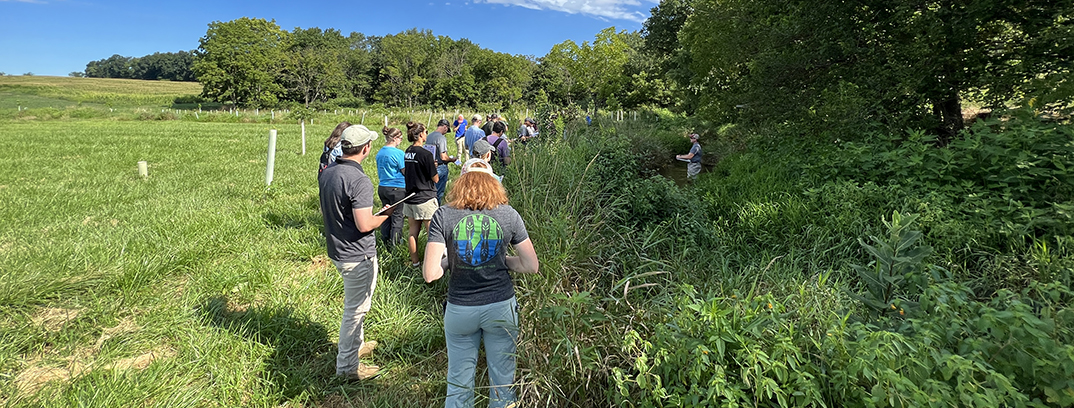Partnerships and trees changing water quality in Lancaster County

A good friend once told me that if you want to build strong, enduring partnerships, you need to bring people together and get their hands dirty! The key to partnerships is connection, and people have a habit of chatting and connecting when their hands are busy.
This advice proved true in late May, when for the first time ever our Action Teams came together to plant 2.5 acres of riparian forest buffer at Overlook Park in Manheim Township in Lancaster County. The Action Teams are boots on the ground experts and technical service providers specializing in differing fields, including agriculture, buffers, data management, communications, watersheds, and stormwater.
But for those four hours planting the buffer along the Little Conestoga Creek, among the birds and critters, we were all buffer experts. Despite the unseasonal heat, volunteers dug holes, planted trees, and hammered stakes with near-constant grins and conversation. It was a feeling deeply missed and deeply needed after months of physical distancing.At the end of the day, about 500 native trees—provided by the Keystone 10 Million Trees Partnership—were planted next to the creek. The crew will get together again with the goal of fully reforesting more than eight acres by the end of the year.
In Lancaster County, trees are an essential tool for cleaning our streams because they reduce urban runoff, erosion, and restore streams to their natural beauty and function.
Despite Pennsylvania’s namesake of Penn’s Woods, trees are not abundant in the southeastern part of the state. Luckily—and not surprisingly!—diverse organizations within the county are coming together to plant and maintain forest buffers, among other clean water implementation practices. The Buffer Action Team alone has a goal of planting 6,000 new acres of riparian forest buffers by 2025. That’s a lot of trees and requires a lot of partnerships!
The collaborative efforts coordinated by the Lancaster Clean Water Partners has led to an increase in restoration projects across the county. But unlike the other acres of planted buffers, this one was a purposeful joint effort between a dozen partner organizations as a celebration of the collaborative environment in the county. This project, located in a highly visible location in the community, will help to significantly advance water quality in the Little Conestoga Creek watershed and beyond. The community will have an opportunity to observe and enjoy the buffer in this public park while also enjoying the benefits of improved local waterways.
Based on the Chesapeake Bay Nutrient and Sediment Load Reduction Model, this initial 2.3 acre planting will annually filter out 59 pounds of nitrogen, 2.6 pounds of phosphorus, and 3,471 pounds of sediment.
Thanks to our partners that participated in the planting:
- Alliance for the Chesapeake Bay
- Chesapeake Bay Foundation
- Chesapeake Conservancy
- Lancaster Conservancy
- Lancaster County Conservation District
- NAACP Lancaster’s Environment and Climate Justice Committee
- Penn State Agriculture and Environment Center
- Pennsylvania Department of Conservation and Natural Resources
- Stroud Water Research Center
- TeamAg, Inc.
- Working Lands Investment Partners
—Emily Smedley, Communications and Program Manager at the Lancaster Clean Water Partners


















